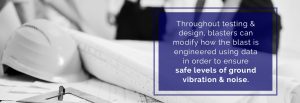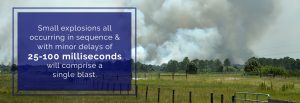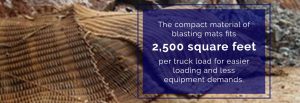
What is Controlled Blasting?
When it comes to controlled blasting for commercial operations, hours and sometimes even days of careful planning and creating safety measures are needed in order to make sure the explosive force of the blast successfully accomplishes the goal set forth. Controlled blasting involves the use of powerful explosives to break apart rock, land and other types of materials so it can be excavated. In some cases, especially when dealing with harder types of rock, explosives are the only feasible tool for the job and blast mats play an essential role in controlling flyrock and debris.
Since explosive force is applied in the operations, professional and well-trained blasters are responsible for the planning and preparation of the blast site. By using specialized equipment and techniques to complete the task with precision, they can design a blast based on a variety of factors.
REQUEST A QUOTE
In order to determine how to approach each blasting project, a series of preparations needs to be made in advance. Also, there are a number of state, federal and local laws, codes and regulations that need to be addressed before conducting any type of commercial blasting operation. Often this will be conducted by a contractor or subcontractor who will follow the procedure and operations set forth by the developer or government entity responsible for excavating the site.
Blasters use a variety of techniques to control the blast, minimize vibration in the earth, and reduce air-blasts to maintain safety and keep the impacts from harming structures. This can often be achieved through spacing and depth in the drilled holes, the quantity of explosives placed, and the timing sequence used to delay the actual detonators. In addition, blasting mats are often used. Blasting mats are essential components, and their design can be customized depending on the project’s needs.
Site Preparation
Before the site can be designed and prepared for blasting, the hardness and type of rock must be assessed to determine:
- What type of explosives may be needed
- How large the magnitude of the blast should be
- Feasibility of excavation

In addition, surveying the surrounding areas for nearby commercial and residential developments, infrastructure and other environmental factors is needed to determine if the site is safe for blasting.
When planning for a commercial blast, it is important to create the least amount of disturbance as possible, which includes limiting noise and vibration, maintaining rigorous safety standards, and community outreach if the blast may cause some disturbance to nearby businesses and residents. When preparing for a blast, planning for the limiting of noise and vibration is further controlled by strict state and federal guidelines.
Noise is determined by the proximity of the blast from nearby communities or structures. When blasting, contracting specifications limiting air-blasts and vibration stretch far below what could be considered damage-inducing levels. However, people nearby may still experience the vibrations and even some noise from a commercial blast.
When preparing for a blast, determining the extent of blast vibrations is also important to not cause damage to nearby structures that are also enforced by strict regulations. Extra steps may be taken to further reduce vibration and noise during the design phases and can be well below even regulated levels.
Test Blasting
Before the design phase, a test of the explosive is conducted and monitored to determine seismic activity and other data that can then be used later when designing the blast that adheres to a range of controls and safety regulations. By using seismographs, blasters can determine and measure the effects to nearby areas.
Many complex instruments are also employed to measure ground vibration and the noise traveling through the air. While not always employed, sophisticated computer programs may be used during test blasting to further the results.

Each time a test blast is conducted, blasters can view accurate data and fine-tune the operation to fall within the specific limits the contractor or government agency employs as well as the many state, federal and local regulations that may be required. Throughout testing and design, blasters can also further modify how the blast is engineered using this data in order to ensure safe levels of both ground vibration and noise.
Seismographs used in the operation must be extremely accurate. The most important step in monitoring the test blast is to gain reliable data in order to maintain safety and stay within the legal limits. Seismographs are calibrated and certified by their manufacturer and also have a built in diagnosis systems to ensure proper usage. Using well-maintained and proper equipment is essential when conducting any type of commercial blasting.
While much planning and work is involved in preparing for the blast, there are still a number of factors that may fall outside the control of the blaster. Weather can impact the results as well as the slope of the land mass and other geological factors. When planning and conducting test blasts, engineers do their best to anticipate any effects and adjust their controls of the blast as a result. Primarily, controlling vibration and noise can also be achieved by:
- How large the explosive charges are
- How they are placed within the rock
- The timing and delay sequences used during the operation
Designing the Blast
Designing a blast is a complex process that factors in all of the data used from testing as well as the preparation steps and initial assessments. Blasters are tasked with determining the size, or magnitude, of the explosive used and what type of explosive will work best. Other factors considered during the design phase include determining the depth, diameter and number of holes that need to be drilled as well as the spacing.
In order to control the sequence of the explosion, the number of detonations, the timing and delay sequences give the blaster more control over the variables. Through the use of surveying, assessing the hardness of the rock, and the overall ground vibration and air-blast data collected during testing, blasters need to determine the amount of explosive to place in each hole.

The technique of using sequential blasts within a specific spacing and through the use of delay systems and blasting caps can allow a blaster to garner more control over the process while staying within the safe and legal limits required. Carefully designing sections in delay periods and adjusting the amount of explosive pounds per delay can help increase desired fragmentation. Together these small explosions, all occurring in sequence and with minor delays of 25-100 milliseconds will comprise the single blast.
As with testing, numerous preparations and assessments are conducted during the design phase to maximize the fragmentation results and minimize the impact it will have on surrounding areas. While the noise level will depend on the proximity from a blast, a “popping” sound is more common than a loud bang that would be depicted in a Hollywood film.
After all assessments have been made, holes will be drilled into the rock at a specified diameter, depth and spacing before being loaded with explosive material. High explosives that detonate rapidly or low explosives that create pressure during the burn can be used. The use of either dynamite explosives or powder-based explosives is determined during the design phase. Once the spacing and sequence is determined, you can add:
- Detonators
- Cartridges
- Charges
- Fuses
In some blasts, blasting caps may be used to detonate more powerful explosives such as dynamite.
Preventing Flyrock in Blasting
Because of the volatile and potentially dangerous nature of explosives, special storage requirements under state and federal law must be applied in both transportation and storage at the blasting site. When in storage, a heavy wooden interior with a metal exterior is required in addition to the use of special locking mechanisms that cannot be tampered with. On the job site, regulations allow for storage to be built in either a truck or a separate, portable magazine.
In order to prevent flyrock, or debris that is flung into the air during the blast, blast mats are commonly used. Blasting mats are essentially blankets comprised heavy rope or steel or rubber which get put over the loading holes before detonation to help contain the explosive force. Depending on the nature of the design, varying sizes of blasting mats may be used. Read on to learn more about our woven metal blasting mats and how they can be applied in drilling and mining construction applications.
Wire rope blasting mats offer many advantages over others because of their interwoven design. They are affordable and reusable assets that provide excellent durability and safety advantages. Blast mats can adapt to different topography.
There’s no need to prepare your site for installation or take care of dangerous gaps in coverage. The mats come in sizes ranging from 4′ x 6′ to 14′ x 16′. You can always contact T.M. International, LLC, your supplier of construction blast mats, if your needs exceed those parameters, as customized measurements are also available.
In addition, wire rope mats are fire resistant and offer superior performance over rubber blast mats because of the woven steel design, which allows gases from the explosion to vent. When blasting, rubber mats do not allow for the ventilation of gases, causing pressure build up, which sends them airborne.

With steel rope design, blasting mats will not become dangerous debris that can threaten crew members and surrounding areas. In addition, the highly lightweight design allows for easy transport. The compact material fits 2,500 square feet per truck load for easier loading and less equipment demands.
The Blast
After days and hours of work assessing, planning and testing the blast site, the actual blast is a relatively short process in comparison, but there is no disappointment in the desired fragmentation after carefully planning each step of the process.
On the day of the blast, crews will load the explosive materials into the holes while placing the charges, blasting caps, detonators, fuses, wiring and other equipment needed to get the blast underway. Blasting mats will then be placed in the proper areas to prevent flyrock and contain the explosion. As the process is completed, the shot area will be secured before the site is evacuated.
If you are a business owner or resident, the blaster will notify you far in advance of the scheduled time and date of the blast as to not cause alarm. At the five-minute warning, a loud horn will sound in a series signaling the countdown to detonation.
After four of those minutes, another series of short horn blasts with longer stretches in between will sound, signifying one minute until the blast. Once more there will be a signal to give the go ahead to begin the blast, a long-sounding horn signifying all is clear and ready for the explosive force to be unleashed upon the rock.
At this point, the blaster will initiate the process, and if planned successfully, will create the desired fragmentation required for the job. While the blast might have appeared to have gone without any issues, the site is then inspected by professionals to determine all of the explosives detonated properly and the area is safe. If all is secure, another horn will blast, signifying the end of the process.
Controlled Blasting Legal Aspects You Need to Know
Law regulation regarding controlled blasting is necessarily rigid, with many specific requirements to meet before receiving approval for your project. Adhering to safety standards and laws is crucial when working around controlled blasting to protect your workers, the environment and local citizens. Please note, the below information is not legal advice.
Obtaining the proper permit is the first step in legally acquiring permission to perform controlled detonations at the blasting site. To complete your permit application, make sure you include the following details:
- Names and identifying information of all employees you’re authorizing to possess explosive materials
- Fingerprints of individuals involved in the blasting process
- Updated photographs of each employee
- The proper fee of up to $50 for a limited permit and up to $200 for any other controlled blasting license
Limited permits are valid for up to one year and other licenses are valid for up to three years. Remember that permit holders are subject to inspection within reasonable hours to ensure they are following regulations.
Essential Law Regulations to Enforce
Even with a permit for your blasting operation, you must follow a strict set of requirements. Several key standards to keep in mind include:
- Report any theft or loss of explosive material within 24 hours.
- Ensure a detection agent is included in all plastic explosives that you transport, receive or manufacture.
- Avoid transporting, possessing or disposing of any stolen explosive materials.
When Are Controlled Explosives Required?
Controlled explosions are often used to clear large amounts of debris from areas to prepare them for construction or excavation. Production blasting is an effective way to remove heavy materials quickly and increase the efficiency of construction or engineering projects.
Controlled explosions are required in many circumstances, including:
- Rock excavation: Rock blasting allows workers to clear high rock masses to prepare areas for construction.
- Mining: Controlled blasts allow miners to access deeper crevices in the earth.
- Civil engineering: Many engineering projects such as road, tunnel or dam construction require explosives.
- Quarrying: Quarry workers use controlled blasts to gain access to deposits of the material they’re harvesting.
After following all regulations and appropriately using the detonations, you can ensure controlled blasting results are safe and efficient. Explosives are a standard and effective tool in numerous applications.
Types of Explosives and Blasting Methods
There are many types of blasting techniques and various explosives used according to the application at hand, such as if you are dealing with hard or soft rock. Many controlled detonations are accomplished with emulsion explosives, which contain ammonium nitrate. These explosives are especially common in mining and coal blasting procedures.
Two standard blasting methods include:
- Cushion blasting: Also called trim blasting, this method uses a single row of decoupled holes to fire along an excavation line and cut the rock closely between holes.
- Perimeter blasting: This is a type of blasting, used in tunnels, designed to produce clean-cut solid walls and reduce overbreak. Holes are loaded with light, consistent explosives and fired at once to shear from one hole to the next.
Both of these excavation methods require considering the blast line and hole diameter to ensure accuracy and safety. The hole diameter affects the blast’s precision, while the blast line identifies the area affected by the explosion.
How Can T.M. International, LLC, Help Me?
As mentioned, wire rope blasting mats made from steel cable are essential in preventing flyrock and containing a blast. In many cases there are strict state, federal and local regulations that require the use of blasting mats. While rubber and other materials can be used for blasting mats, steel is one of the most advantageous materials, especially woven steel mats.
At T.M. International, our Mazzella blasting mat products are designed for construction operations that involve drilling and blasting. All blast mats come in a wide range of sizes, including customized solutions for your special projects. Steel cable blasting mats offer superior performance and longevity over rubber mats.
With a reusable, fire-resistant design, the ability to vent gases during a blast, and lightweight features, steel cable blasting mats are faster to install and easier to remove. In addition, the longevity provided will save your business money and can be used in a wide range of topographic features. We’re capable of making our products match your needs. Whatever the explosive material you are using for your blast, our products can handle it. The steel blasting mats we provide have been designed to withstand every type of explosive substance available as well as any style of detonation device used.
Save money, stay protected and be as productive as possible knowing your liabilities are covered. Contact us today to find out which blasting mats are best for your business.




